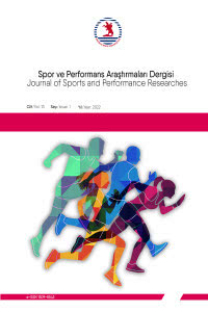KAOSUN ÖRGÜTSEL DEĞİŞİM ÜZERİNDEKİ ETKİSİ: PROFESYONEL FUTBOL KULÜPLERİ ÜZERİNE BİR ÇALIŞMA
Değişim; Futbol Kulüpleri; Kaos; Stratejik Yönetim
THE EFFECT OF CHAOS ON ORGANIZATIONAL CHANGE: A STUDY ON THE TURKISH PROFESSIONAL FOOTBALL CLUBS
___
- Hannan M, Freeman J. Structural inertia and organizational change. American Sociological Review 1984; 49(2):149-164.
- Montalvo C. What triggers change and innovation? Technovation 2006; 26(3): 312–323.
- Kiel LD. Managing Chaos and Complexity in Government: A New Paradigm for Managing Change, Innovation, and Organizational Renewal. San Francisco: Jossey-Bass Publishers. 1994. p.1-246.
- Ford JD, Ford LW, D'Amelio A. Resistance to change: The rest of the story. Academy of Management Review 2008; 33(2): 362-377.
- Buchanan D. Getting the story straight: Illusions and delusions in the organizational change process. Tamara Journal for Critical Organization Inquiry 2013; 2(4): 7-21.
- Demers C. Organizational change theories: A synthesis. 1st ed. Alberta: Sage Publications; 2007. p. 115-222.
- Farazmand A. Chaos and transformation theories: A theoretical analysis with implications for organization theory and public management. Public Organization Review 2003; 3(4): 339–372.
- Cartwright TJ. Planning and Chaos Theory. Journal of the American Planning Association 1991; 57(1): 44–56.
- Griffiths DE, Hart W, Blair BG. Still Another Approach to Administration: Chaos Theory. Educational Administration Quarterly 1991; 27(3): 430–451.
- Levy D. Chaos Theory and Strategy: Theory, Application, and Managerial Implications. Strategic Management Journal 1994; 15: 167–178.
- Levy D. Applications and Limitations of Complexity Theory in Organization Theory and Strategy. Public Administration and Public Policy 2000; 79: 67-88.
- Brown SL, Eisenhardt KM. The Art of Continuous Change: Linking Complexity Theory and Time-Paced Evolution in Relentlessly Shifting Organizations. Administrative Science Quarterly 1997; 42(1): 1.
- O’Brien D, Slack T. Deinstitutionalising the Amateur Ethic: An Empirical Examination of Change in a Rugby Union Football Club. Sport Management Review 1999: 2(1); 24–42.
- Smith ACT. Complexity theory and change management in sport organizations. E:CO Special Double Issue 2004; 6(1-2); 70–79.
- Girginov V, Sandanski I. Understanding the Changing Nature of Sports Organisations in Transforming Societies. Sport Management Review 2008; 11(1): 21–50.
- Burnes B. Kurt Lewin and complexity theories: back to the future? Journal of Change Management 2004; 4(4): 309–325.
- Pettigrew AM, Woodman RW, Cameron KS. Studying organizational change and development: Challenges for future research. Academy of Management Journal 2001:44(4);697-713.
- Bamford DR, Forrester PL. Managing Planned and Emergent Change Within An Operations Management Environment. International Journal of Operations & Production Management 2003; 23(5): 546–564.
- Burnes B. No such thing as … a “one best way” to manage organizational change. Management Decision 1996; 34(10): 11–18.
- Cummings TG, Worley CG. Organization Development and Change. Designing Interventions. 9th ed. Mason, Ohio: Thomson/South-Western; 2009. p. 151-163.
- Todnem R. Organisational change management: A critical review. Journal of Change Management 2005; 5(4): 369–380.
- Sturdy A, Grey C. Beneath and Beyond Organizational Change Management: Exploring Alternatives. Organization 2003; 10(4): 651–662.
- Ven A, Poole MS. Alternative Approaches for Studying Organizational Change. Organization Studies 2005; 26(9): 1377-1404.
- Orlikowski WJ, Yates J. It’s About Time: Temporal Structuring in Organizations. Organization Science 2002; 13(6): 684-700.
- Wetzel R, Van Gorp L. Eighteen Shades of Grey? An Explorative Literature Review into The Theoretical Flavours of Organizational Change Research. Journal of Organizational Change Management 2014; 27(1): 115–146.
- Skirstad B, Chelladurai P. For “Love” and Money: A Sports Club’s Innovative Response to Multiple Logics Theoretical Framework: Journal of Sport Management 2011; 25: 339–354.
- Bloyce D, Smith A, Mead R, Morris J. ‘Playing The Game (plan)’: A Figurational Analysis of Organizational Change in Sports Development in England. European Sport Management Quarterly 2008; 8(4): 359-378.
- Slack T, Hinings B. Understanding Change in National Sport Organizations: An Integration of Theoretical Perspectives. Journal of Sport Management 1992; 6(2): 114–132.
- Stenling C. The Introduction of Drive-in Sport in Community Sport Organizations as an Example of Organizational (Non-) Change. Journal of Sport Management 2013; 27(6): 497–509.
- Amis J, Slack T, Hinings C. The pace, sequence, and linearity of radical change. Academy of Management Journal 2004; 47(1): 15–39.
- Mcbride N. Information Systems in Organizations. Info Systems J 2005; (15): 233–254.
- Hayles, K. Instability and Narrative Order. In: Chaos and Order: Complex Dynamics in Literature and Science. The Employment of Chaos. Chicago: University of Chicago Press; 1991;100-125.
- Stacey R. Emerging strategies for a chaotic environment. Long Range Planning 1996; 29(2): 182–189.
- Şimşek H, Yıldırım A. [Qualitative Research Methods in Social Sciences]. Sosyal bilimlerde nitel araştırma yöntemleri. Nitel Araştırma Desenleri ve Süreci. 10. Baskı. Ankara: Seçkin Yayıncılık; 2011;50-87.
- Berg BL, Lune H. Qualitative Research Methods for the Social Sciences. 5th ed. Boston: Pearson; 2004; 21-60.
- Grbich, C. Qualitative Data Analysis: An Introduction. 2nd ed. London. SAGE; 2013;1-25.
- Altun SA. [Chaos and Management]. Kaos ve Yönetim. Kuram ve Uygulamada Eğitim Yönetimi Dergisi 2001; 7(4): 451-469.
- Sherry E, Shilbury D. Board Directors and Conflict of Interest: A Study of A Sport League. European Sport Management Quarterly 2009; 9(1): 47-62.
- Tekel, S. [Complexity Theory in Management and Organization Sciences]. Yönetim ve Organizasyon Bilimi Açısından Karmaşıklık Teorisi. Journal of İstanbul Kültür University 2006; 2: 223–229.
- Guimaraes T, Armstrong C. Empirically Testing the Impact of Change Management Effectiveness On Company Performance. European Journal of Innovation Management 1998; 1(2): 74–84.
- ISSN: 1309-5110
- Yayın Aralığı: 3
- Başlangıç: 2010
- Yayıncı: Ondokuz Mayıs Üniversitesi Yaşar Doğu Spor Bilimleri Fakültesi
AJLAN SAÇ, Merve AKTAŞ, HALİL ÇOLAK
ZARİFE PANCAR, MÜRSEL BİÇER, MUSTAFA ÖZDAL
KAOSUN ÖRGÜTSEL DEĞİŞİM ÜZERİNDEKİ ETKİSİ: PROFESYONEL FUTBOL KULÜPLERİ ÜZERİNE BİR ÇALIŞMA
Bahadır Rıza ALTUNAY, VELİTTİN BALCI
MUZAFFER SELÇUK, Tahir Volkan ASLAN, Hacı Bayram TEMUR, Vedat ÇINAR
Zarife PANCAR, Mürsel BİÇER, Mustafa ÖZDAL
GENÇ YETİŞKİN KADINLARDA DÜZENLİ AEROBİK EGZERSİZLERİN İNFLAMATUAR BELİRTEÇLER ÜZERİNE ETKİSİ
HALİT BUĞRA KOCA, İRFAN YILDIRIM, ÖZKAN IŞIK, TÜLAY KOCA, Tuncay BALKAYA
